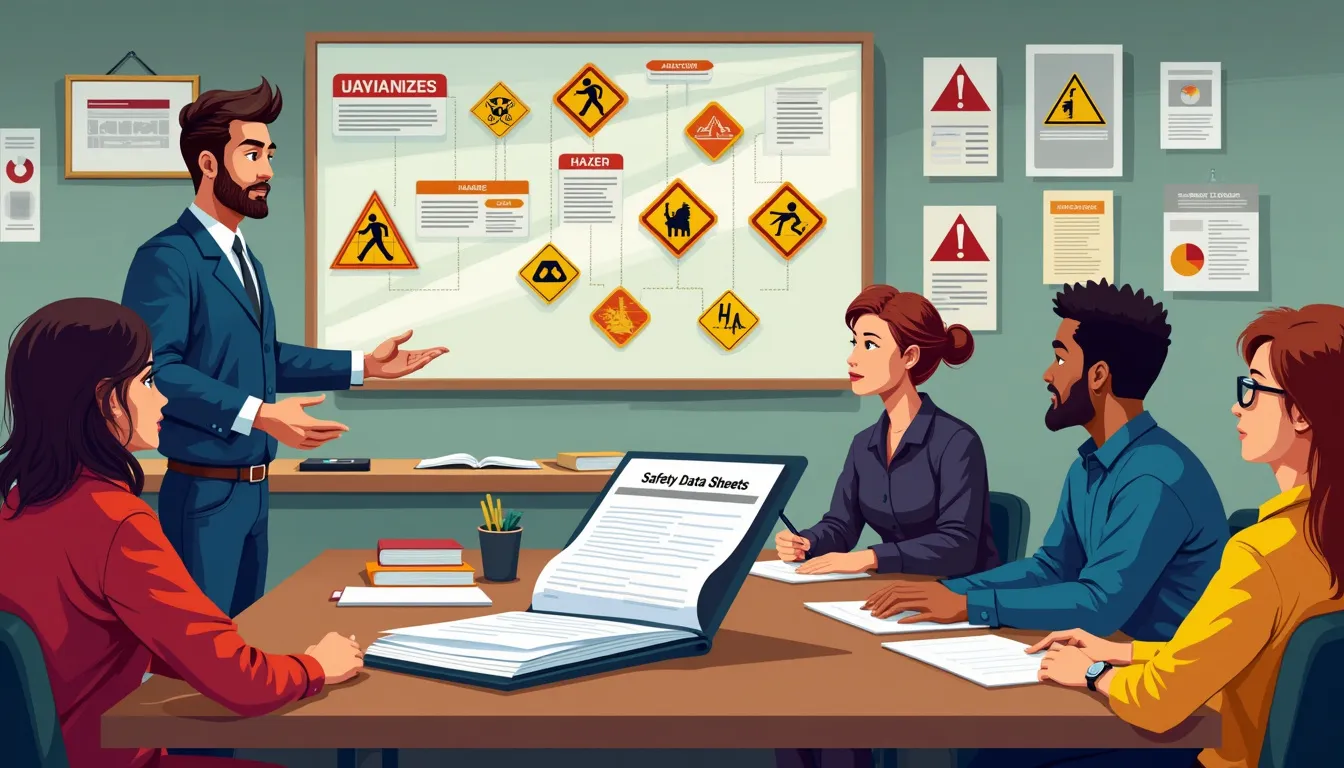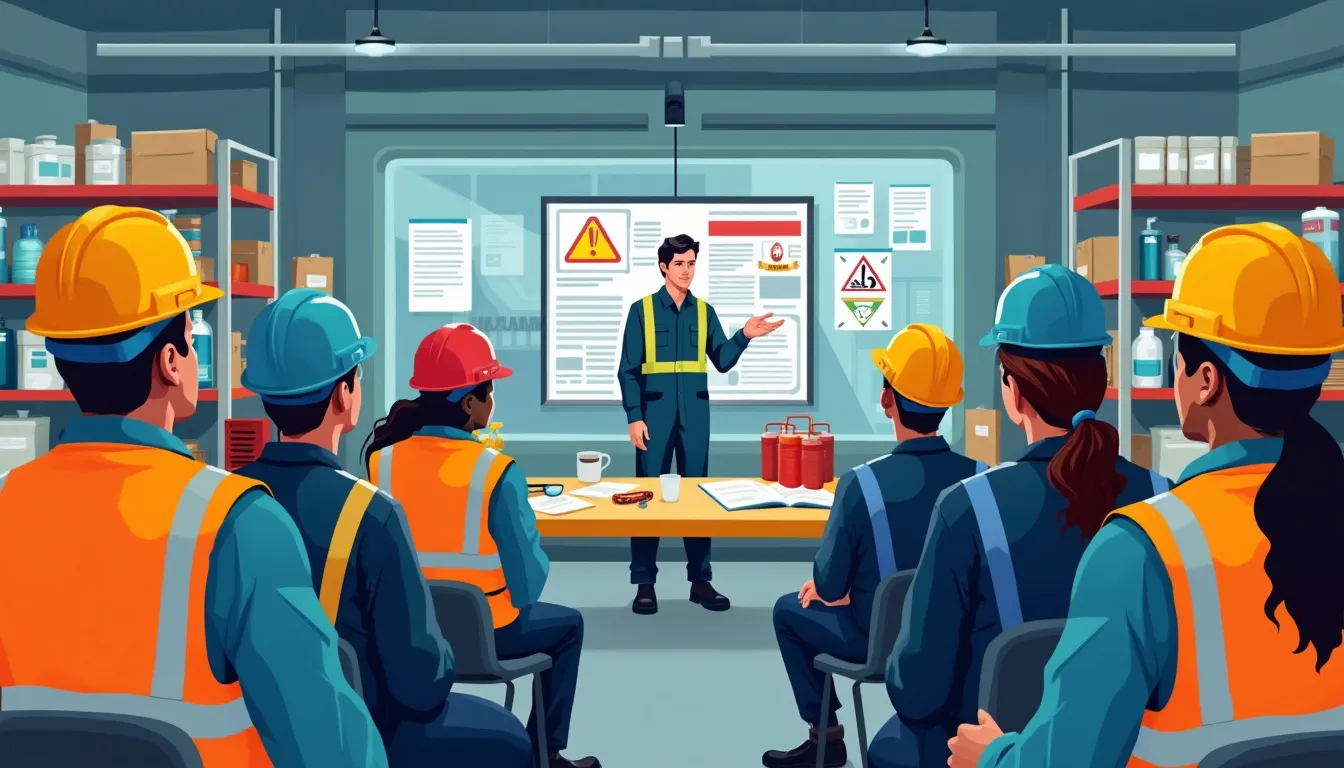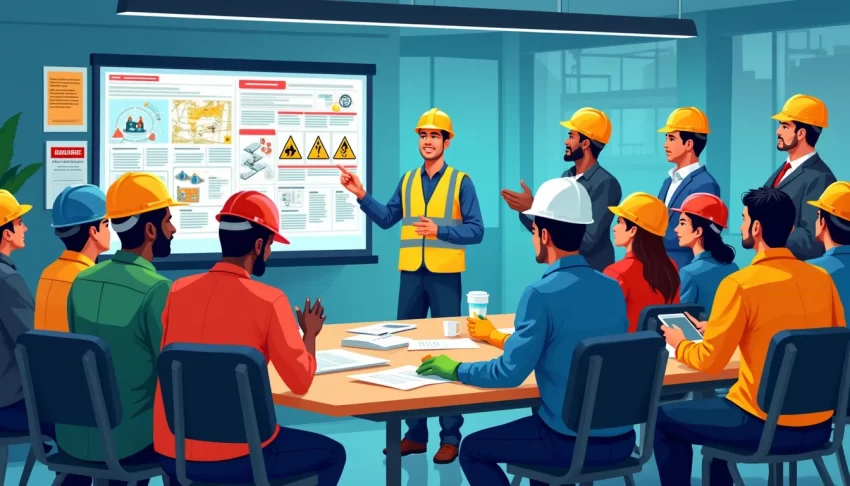In the intricate dance of workplace safety, understanding the tune of hazard communication training is not just important—it’s essential. As the foundation of a safer work environment, this training educates and empowers employees to recognize and properly handle potential dangers, fostering a culture of vigilance and preparedness. Governed by rigorous standards set by OSHA and the globally harmonized system (GHS), hazard communication training demystifies the myriad of risks that lurk within worksites, from chemical exposures to physical hazards. By comprehensively deciphering labels and safety data sheets (SDS), deploying effective communication strategies, and delineating clear roles and responsibilities, this training transforms theoretical knowledge into practical action. Developing a robust hazard communication training program—whether through online modules, in-person sessions, or a blend of both—ensures that safety procedures are not only learned but ingrained. Regular refreshers and continuous improvements further cement this knowledge, creating a resilient safety culture. Ultimately, such diligent training significantly reduces workplace incidents and accidents, enhances compliance, and bolsters employee confidence and awareness, resulting in a harmonious, secure working environment. Hazard communication training isn’t just a regulatory necessity; it’s the keystone of occupational safety.
Introduction to Hazard Communication Training
Definition and Importance
Hazard communication training is an essential protocol designed to inform and educate employees about potential dangers associated with workplace chemicals and substances. At its core, hazard communication training focuses on ensuring that all workers understand the risks linked to hazardous materials and the measures they need to take to protect themselves. It is a crucial component of any occupational safety strategy, fundamentally aimed at preventing injuries, illnesses, and incidents that can arise from exposure to hazardous substances.
Understanding the importance of hazard communication training goes beyond compliance; it is about fostering a culture of safety. When employees are well-informed about hazards and the precautions they must take, they feel valued and protected, which can significantly enhance workplace morale and productivity. Furthermore, proper training can drastically reduce the likelihood of costly accidents and liabilities, making it an indispensable investment for any organization.
Regulatory Requirements (OSHA, GHS)
The necessity for hazard communication training is underscored by various regulatory mandates, overseen by agencies such as the Occupational Safety and Health Administration (OSHA) and guidelines like the Globally Harmonized System of Classification and Labelling of Chemicals (GHS).
OSHA’s Hazard Communication Standard (HCS) imposes robust requirements on employers. They must develop a hazardous materials communication program that includes comprehensive training for all employees. The aim is to ensure that workers can readily identify and understand hazards through standardized labeling and safety data sheets (SDS), and know precisely what actions to take in the event of an emergency involving hazardous substances.
GHS, adopted globally, complements OSHA’s framework by harmonizing the classification and labeling of chemicals across different countries. It provides a consistent approach to defining and communicating hazards. This is crucial in a global economy where materials and labor frequently cross borders. GHS makes sure that the communication of chemical hazards is clear and universally understood.
Adhering to these regulatory requirements is non-negotiable. Non-compliance can result in severe penalties, legal actions, and a tainted organizational reputation. Therefore, embedding hazard communication training within your operations not only keeps you in line with the law but also proves your commitment to creating a safe working environment.
Overview of Potential Workplace Hazards
Workplace hazards span a broad spectrum, and they can vary significantly from industry to industry. The main categories of hazards include chemical, physical, biological, and ergonomic hazards, each presenting unique risks and requiring specific preventive measures.
Chemical hazards are perhaps the most prominent focus of hazard communication training. These include any form of chemical substances that can cause harm, such as solvents, flammable liquids, acids, bases, and toxics. Understanding the properties, safe usage, storage, disposal, and emergency procedures of these chemicals is a vital part of the training.
Physical hazards encompass conditions or substances that threaten physical safety. This category includes but is not limited to excessive noise, radiation, extreme temperatures, and unguarded machinery. Training employees on recognizing and mitigating these hazards can prevent countless injuries and health issues.
Biological hazards refer to risks from biological agents such as bacteria, viruses, fungi, and other microorganisms. These are particularly relevant in industries like healthcare, agriculture, and biotechnology. Proper training equips employees with knowledge on controlling exposure and handling incidents effectively to avoid infections and illnesses.
Ergonomic hazards stem from workplace conditions that pose risks to musculoskeletal health due to poor design or repetitive strain. Examples include improper workstation setup, bad posture, and repetitive motions. Training in ergonomics focuses on recognizing these risks and implementing corrective practices to prevent posture-related injuries and enhance overall employee comfort and efficiency.
An effective hazard communication training program must provide a thorough understanding of these potential hazards. Workers need to be adept at recognizing these dangers, understanding the appropriate precautionary measures, and knowing the protocols to follow when an incident occurs. Through comprehensive training, employers empower their workforce with the crucial knowledge and skills needed to maintain a safer workplace.
Safetyology – Get The Book Today!

Key Components of Hazard Communication Training
Labeling and Safety Data Sheets (SDS)
Understanding how to read and interpret labels and Safety Data Sheets (SDS) is the cornerstone of effective hazard communication training. Labels on chemical containers provide crucial information, including product identifiers, signal words, hazard statements, precautionary statements, and supplier identification. These elements are essential for alerting employees to the dangers associated with particular substances and for guiding safe handling practices.
An SDS is a comprehensive document detailing the properties of a chemical product, including potential hazards, safe handling procedures, and emergency control measures. Training should cover the standardized 16-section format of the Globally Harmonized System (GHS) SDS, ensuring employees can easily locate information such as first-aid instructions, firefighting measures, and exposure controls. Properly understanding these documents not only safeguards employees but also ensures compliance with regulatory requirements such as OSHA’s Hazard Communication Standard (HCS).
Effective Communication Strategies
Clear, concise, and efficient communication is vital to the success of any hazard communication training program. Employees must be able to effectively convey hazard information among themselves and to external parties such as contractors and emergency responders.
Interactive and engaging training methods can significantly enhance communication effectiveness. Role-playing scenarios, multimedia presentations, and group discussions can provide practical, real-world insights into how to handle hazard communication. The training should also emphasize the importance of consistent terminology and visual aids, such as pictograms and hazard symbols, to bridge language barriers and ensure universal understanding.
Moreover, regular updates and refreshers are critical in maintaining communication efficacy. As new hazards emerge or when there are changes in regulations, updating training materials and holding refresher sessions reinforces knowledge and keeps everyone on the same page.
Employee Roles and Responsibilities
A well-defined structure of roles and responsibilities forms the backbone of a successful hazard communication program. Every employee, from entry-level workers to top management, has a part to play.
Employees on the front lines need to be vigilant in recognizing and reporting hazards. They should be trained to understand the hazards specific to their tasks, how to properly use personal protective equipment (PPE), and the procedures for dealing with spills, leaks, or other emergencies. Compliance with established safety practices and participation in regular safety meetings are typical responsibilities.
Supervisors and middle managers play a crucial role in enforcing safety protocols and ensuring that employees adhere to training guidelines. They should facilitate open communication, promptly address safety concerns, and ensure that all team members have access to up-to-date hazard information.
Senior management and organizational leaders have the responsibility to establish a safety culture and provide the necessary resources for effective hazard communication. Their commitment to prioritizing safety, demonstrated through policies, procedures, and a proactive approach to training, significantly influences overall compliance and workplace morale.
In essence, hazard communication training is not a one-time event but a continuous effort requiring the active participation of everyone within the organization. By delineating clear roles and responsibilities, an organization can foster a collaborative environment where safety and compliance become integral parts of the daily workflow.
Effective hazard communication training is a multifaceted approach that blends regulatory compliance with practical safety measures. Mastering the key components—comprehensive understanding of labeling and SDS, fostering robust communication strategies, and clearly defining employee roles and responsibilities—ensures not only legal compliance but also a safer, more informed, and engaged workforce.
Safetyology – Get The Book Today!

Implementing a Hazard Communication Training Program
Developing Your Training Plan
Creating a robust hazard communication training plan is the cornerstone of a safer workplace. Begin by performing a detailed hazard assessment to identify specific risks and requirements pertinent to your environment. This assessment should be thorough, covering every nook and cranny where potential hazards lurk.
Once you have a comprehensive understanding of your workplace hazards, tailor the training modules to address these unique risks. Incorporate the principles of adult learning to ensure the training is engaging and effective. Consider a mix of theoretical knowledge and practical applications to keep employees not just informed but also competent in managing real-world scenarios.
The structure of your hazard communication training program should include clear objectives, timelines, and measurable outcomes. Align your training plan with regulatory standards like OSHA and the Globally Harmonized System (GHS) to ensure full compliance and maximum protection for your workforce.
Training Methods (Online, In-Person, Blended)
Select the appropriate training method based on your organization’s needs, resources, and learning culture.
In-Person Training: Traditional classroom-style training remains highly effective for hands-on learning. Real-time interactions with trainers allow for immediate clarification of doubts and provide opportunities for practical demonstrations. Ensure your trainers are not only knowledgeable but also skilled in engaging participants.
Online Training: This method is advantageous for its flexibility, allowing employees to complete modules at their own pace. Online training platforms can be cost-effective and scalable, making it easier to update content regularly. It’s important to include interactive elements like quizzes and simulations to keep the training immersive and engaging.
Blended Training: Combining online and in-person methods can offer the best of both worlds. For instance, theoretical components can be covered online, while practical scenarios are handled on-site. Blended training ensures comprehensive understanding while accommodating different learning styles and schedules.
Periodic Refreshers and Continuous Improvement
Hazard communication training shouldn’t be a one-time affair. Regular refreshers are essential to reinforce safety protocols and update employees on new hazards or regulatory changes. Schedule these refreshers periodically—annually at minimum—to maintain a high level of awareness and preparedness.
Continuous improvement is integral to the effectiveness of hazard communication training. Collect feedback from training participants to identify areas of enhancement. Assess the training outcomes through audits, assessments, and incident analysis. Use these insights to fine-tune the training modules continuously.
Transparency is key. Regularly communicating the importance of the training and the specific updates instills a culture of proactive safety. A dynamic hazard communication training program not only ensures compliance but also empowers employees to take ownership of their safety and that of their colleagues.
Implementing a well-structured hazard communication training program is pivotal in fostering a safer, more informed workplace. With strategic planning, diverse training methods, and a commitment to continuous improvement, your organization can significantly mitigate risks and create a resilient safety culture.
Safetyology – Get The Book Today!

Benefits of Effective Hazard Communication Training
Reducing Workplace Incidents and Accidents
Effective hazard communication training is a cornerstone of occupational safety, directly influencing the reduction of workplace incidents and accidents. By ensuring employees are well-informed about hazardous substances and proper safety protocols, you fortify their ability to identify risks and respond appropriately. Knowledgeable employees are less likely to mishandle materials, reducing the likelihood of spills, exposures, and injuries. In essence, a well-executed hazard communication training program translates to a more vigilant and proactive workforce, safeguarding both employees and the organization from avoidable mishaps.
Enhancing Compliance and Safety Culture
Government regulations such as OSHA’s Hazard Communication Standard (HCS) and the Globally Harmonized System of Classification and Labelling of Chemicals (GHS) set stringent requirements for hazard communication. Effective training assures compliance with these regulations, helping businesses avoid costly fines and legal pitfalls. But beyond mere compliance, hazard communication training fosters a robust safety culture. Employees who understand the significance of safety standards are more likely to internalize and uphold these principles in their daily routines. This cultural shift towards safety not only aligns with regulatory frameworks but also creates an environment where every individual is committed to maintaining workplace safety.
Increasing Employee Awareness and Confidence
One of the pivotal benefits of hazard communication training is the elevation of employee awareness and confidence. Knowledge is empowerment, and a workforce that is well-versed in recognizing and addressing hazards is both confident and competent in executing their roles. Comprehensive training ensures employees can accurately read and interpret Safety Data Sheets (SDS), understand labeling systems, and effectively use personal protective equipment (PPE). When employees are confident in their knowledge and skills, they are better equipped to act decisively in preventing accidents and managing emergencies, thereby contributing to an overall safer and more efficient workplace.
In conclusion, prioritizing hazard communication training is not just a regulatory obligation—it’s a strategic investment in your organization’s safety framework. By understanding and adhering to OSHA and GHS requirements, you’re building a robust defense against potential workplace hazards. Key components such as proper labeling and comprehensive Safety Data Sheets (SDS) lay a solid foundation for effective communication strategies, ensuring that each employee comprehends their essential roles and responsibilities.
Implementing a well-structured hazard communication training program involves meticulous planning, whether through online, in-person, or blended methods. Regular refreshers and a commitment to continuous improvement keep the training dynamic and relevant, reinforcing your safety protocols.
Ultimately, the benefits of effective hazard communication training are multifaceted. It significantly reduces workplace incidents and accidents, fosters a culture of compliance and safety, and enhances overall employee awareness and confidence. Investing in such training pays dividends by creating a safer, more informed, and more resilient workforce.
Safetyology – Get The Book Today!
Support Us: Check out our recommended products on Amazon.

